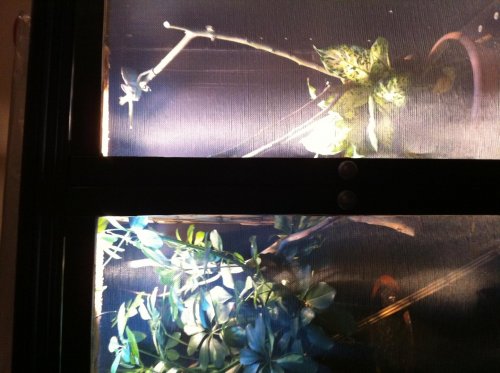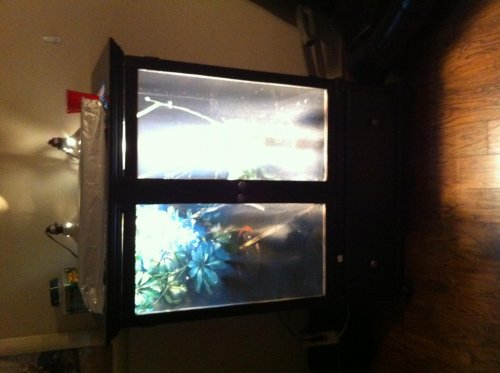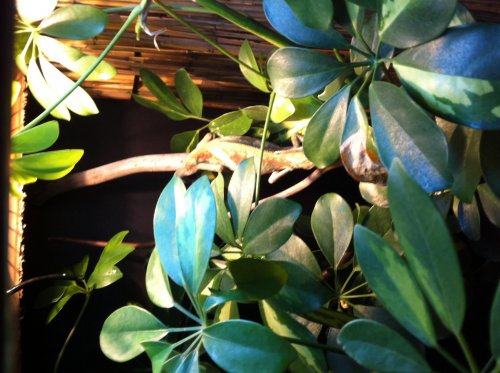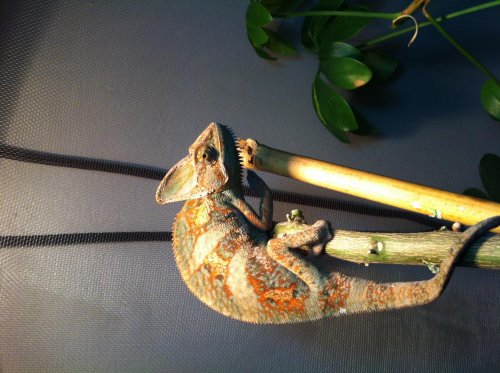Navigation
Install the app
How to install the app on iOS
Follow along with the video below to see how to install our site as a web app on your home screen.
Note: This feature may not be available in some browsers.
More options
You are using an out of date browser. It may not display this or other websites correctly.
You should upgrade or use an alternative browser.
You should upgrade or use an alternative browser.
Bee
- Thread starter Rango3d
- Start date
ReptileLove18
Established Member
did little rango get a bee??
ReptileLove18
Established Member
oops i think i mixed you up with another rango, one from the uk! lol  sorry
sorry
Cainschams
New Member
If you have your chami's outside, and somehow he eats a bee, will they be ok?
Just wondering what kind of bugs they can't eat.
Ive heard very few cases of chams being hurt by bees but there are some. They eat them in the wild and I have seen some of the animals I have kept go crazy for bees, wasps, etc. The panthers I owned absolutely loved them and would eat them all the time with no problems. My smaller species would destroy sweat bees too. There is always a chance something can happen but I think its rather slim, at least seeing how many mine have eaten without a mishap.
They can eat all kinds of bugs from spiders, hoppers, bees, moths, some butterflies, gnats etc etc. You just want to stay away from bugs that are toxic or have been in contact with pesticides.
ReptileLove18
Established Member
yess there is a lot of bees here in cali!  would love to see some pics of your fella rango!!
would love to see some pics of your fella rango!!
Cainschams
New Member
I do have a little Rango, but hes getting pretty big.
No bee for him. I just have a lot of honey bees around and was wonder what happened if he ate one.
You can always catch one, put it in the freezer for a little while but not too long, slow it down, pull out the stinger and then feed it off. This would get rid of any risk and I guarantee he would go crazy for them!
ReptileLove18
Established Member
thats cool! cant wait to see the pics. how old is him and his girlfriend?
Nicolas
New Member
In the wild, I'm pretty sure that they eat a lot of hymenoptera, including bees. Honey bees and solitary bees. There is the Apis mellifera unicolor to Madagascar.
Moreover, bees are a good food. The bee itself and I think that wild chameleons benefit of the virtues of hive products by eating bees. For example by the pollen and propolis clinging to the legs, the honey and nectar ingested...And we know how these products are virtuous.
This is why I give the hive products (pollen, propolos and royal jelly) directly to my chams or as food for my insects. It replace synthetic vitamins.
I started in beekeeping recently, and I want to give the bees drones to my chams. This is convenient because they don't sting and we remove them to prevent varroa.
I want also to give the larvae, they are in particular rich in vit A and D
The nutritive value of drones larvae:
"Celles de faux-bourdon sont composées d’eau de l’ordre de 65 à 68%, de protéines (20%) comme certaines enzymes (amylase, estérases) et un taux élevé de globulines. On retrouve 6% de lipides, 1 à 3%de glucides, 1% de substances minérales, des vitamines, essentiellement A et D et 5% de produits non encore identifiés.
[...]
L’usage des larves est recommandé en cas de fatigue, dans les états asthéniques, dans certains types de convalescence, en cas d’anorexie, dans les troubles de croissance de l’enfant, chez le prématuré ou encore dans certaines affections de la peau. Stimulantes, toniques et activatrices biologiques, elles sont également conseillées lors certains troubles digestifs, en association ou non avec du miel, de la propolis ou du pain d’abeille, en cas d’insomnies, de troubles respiratoires, de carences nutritionnelles, de syndrome prémenstruel, d’aménorrhée.
De plus, elles stimulent la libido, sont bénéfiques pour les personnes âgées et auraient des propriétés protectrices contre les radiations ou certains cancers quand elles sont associées à du miel."
http://scd.unilim.fr/theses/RFpi4R9T.pdf Page 38
Other link:
http://www.apimondia.com/congresses/2001/Papers/294.pdf
http://www.fao.org/docrep/w0076e/w0076e19.htm
Moreover, bees are a good food. The bee itself and I think that wild chameleons benefit of the virtues of hive products by eating bees. For example by the pollen and propolis clinging to the legs, the honey and nectar ingested...And we know how these products are virtuous.
This is why I give the hive products (pollen, propolos and royal jelly) directly to my chams or as food for my insects. It replace synthetic vitamins.
I started in beekeeping recently, and I want to give the bees drones to my chams. This is convenient because they don't sting and we remove them to prevent varroa.
I want also to give the larvae, they are in particular rich in vit A and D
The nutritive value of drones larvae:
"Celles de faux-bourdon sont composées d’eau de l’ordre de 65 à 68%, de protéines (20%) comme certaines enzymes (amylase, estérases) et un taux élevé de globulines. On retrouve 6% de lipides, 1 à 3%de glucides, 1% de substances minérales, des vitamines, essentiellement A et D et 5% de produits non encore identifiés.
[...]
L’usage des larves est recommandé en cas de fatigue, dans les états asthéniques, dans certains types de convalescence, en cas d’anorexie, dans les troubles de croissance de l’enfant, chez le prématuré ou encore dans certaines affections de la peau. Stimulantes, toniques et activatrices biologiques, elles sont également conseillées lors certains troubles digestifs, en association ou non avec du miel, de la propolis ou du pain d’abeille, en cas d’insomnies, de troubles respiratoires, de carences nutritionnelles, de syndrome prémenstruel, d’aménorrhée.
De plus, elles stimulent la libido, sont bénéfiques pour les personnes âgées et auraient des propriétés protectrices contre les radiations ou certains cancers quand elles sont associées à du miel."
http://scd.unilim.fr/theses/RFpi4R9T.pdf Page 38
Other link:
http://www.apimondia.com/congresses/2001/Papers/294.pdf
http://www.fao.org/docrep/w0076e/w0076e19.htm
pamnsam94
Established Member
I want also to give the larvae, they are in particular rich in vit A and D
Do you happen to know whether the bees themselves have significant levels of vitamins A and D? Also, is the vitamin A you are referring to preformed vitamin A or just beta-carotene? Many of us have wondered where non-vertebrate-eating chameleon species might be getting preformed vit A. I've only heard it said that some insects have preformed vitamin A in their eyes, although I don't know which insects. I'm wondering whether adult bees and wasps might be a significant source of preformed A, which is believed by many to increase the viability of chameleon eggs and to be helpful in producing strong neonates.
Perry
Nicolas
New Member
Good questions !
I don't know if bees imagos are rich in vit A and D.
But I know that the pollen is rich in these vitamins and in beta-carotene.
To be exact, bees don't eat directly the pollen collected. It's first stored in cells and nectar, bacteria and enzymes are added. And after a lactic fermention it will be more nutritious and digestible. And it's then called "bees-bread"
Bees larvae are fed with bees-bread and drones larvae in larger quantities.
Bees imagos are still fed with bees-bread but only during them 10 first days, after it's with nectar and honey.
And we must know that bees quit the hive only, in general, at about 3 weeks old so at this time, they don't eat bees-bread but they may still contain these vitamins.
It's the same for drones.
I don't know if bees imagos are rich in vit A and D.
But I know that the pollen is rich in these vitamins and in beta-carotene.
To be exact, bees don't eat directly the pollen collected. It's first stored in cells and nectar, bacteria and enzymes are added. And after a lactic fermention it will be more nutritious and digestible. And it's then called "bees-bread"
Bees larvae are fed with bees-bread and drones larvae in larger quantities.
Bees imagos are still fed with bees-bread but only during them 10 first days, after it's with nectar and honey.
And we must know that bees quit the hive only, in general, at about 3 weeks old so at this time, they don't eat bees-bread but they may still contain these vitamins.
It's the same for drones.
Nicolas
New Member
Some plants countain preformed vitamin A, so if insects, for example grasshopper eat these plants...I've only heard it said that some insects have preformed vitamin A in their eyes, although I don't know which insects.
pamnsam94
Established Member
Some plants countain preformed vitamin A, so if insects, for example grasshopper eat these plants...
Which plants? Any that we can pick up at a grocery store? If so, I'd rather gutload my feeder insects with these plants than to provide a powdered and/or liquid supplement as a preformed vitamin A source. All of the kinds of vitamin A containing vegetables that I'm familiar with only contain beta-carotene, not preformed vitamin A.
Perry
cricketkilla
Member
they are very intelligient creatures, and they naturally know to shoot for the head to avoid the rear-ended stinger. Most animals are pre-wired to interpret the high contrast yellow and black coloration as a caution. very interesting though..
Ive heard very few cases of chams being hurt by bees but there are some. They eat them in the wild and I have seen some of the animals I have kept go crazy for bees, wasps, etc. The panthers I owned absolutely loved them and would eat them all the time with no problems. My smaller species would destroy sweat bees too. There is always a chance something can happen but I think its rather slim, at least seeing how many mine have eaten without a mishap.
They can eat all kinds of bugs from spiders, hoppers, bees, moths, some butterflies, gnats etc etc. You just want to stay away from bugs that are toxic or have been in contact with pesticides.
Nicolas
New Member
Personally, I am choosing to feed my insects with weeds because that is what they eat in the wild, and they are very good !Which plants? Any that we can pick up at a grocery store?
look: http://dragonsdasgard.actifforum.com/t34286-plantes-sauvages-comestibles-pour-lezards-et-tortues
I don't know if you, on the other side of the Atlantic, you have these plants
But there are also vegetables who are rich in vit A and beta-carotene, like carrots for example.
Yes, but are they really harmful ? Some probably, but I think most aren't.I think there is a risk of parasites from any wild caught insect.
In the wild they have also parasites into insects and I think that wild insects are better than our insects, they are more nutritious.
For example, into arthropods we can find gordian. They are dangerous for insects but I don't know if they are really harmfull for the reptile. My chameleons have eaten them and they're fine, no signs of these parasites after coprology

Uploaded with ImageShack.us
Lol it should deter you now but to avoid them, don't collect insects near a waterhole
I always gave wild insects and I would always.






